COMPACT DISC MANUFACTURING PROCESS
A Graphic Explanation of the Manufacturing Steps Used to Create Compact Discs
If you already know this and want to just get on with the ordering, click here for a quote or here for order forms.
How the Process Begins
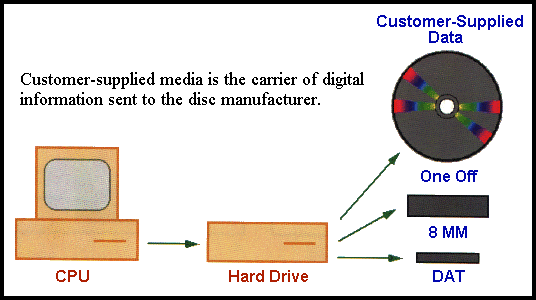

How CD's are Reproduced
1. Glass Master
 From the Customer's data, the CD Glass Master is produced.
From the Customer's data, the CD Glass Master is produced.
- An optically ground glass disc is rotated with a 1/10th micron thick layer of Photoresist which is then exposed by a laser. The laser "writes" or exposes a pattern of pits on this thin layer, transferring the information from the master image. The disk is developed (the exposed parts are etched away), it is silvered, resulting in the actual pit structure of the finished disc.
2. Father
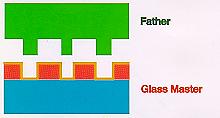 The master is then electroplated with nickel which, when separated from the master, forms a metal negative or "father".
The master is then electroplated with nickel which, when separated from the master, forms a metal negative or "father".
3. Mother
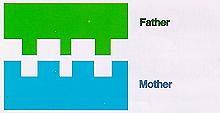 The father could be used to replicate CD's but would wear out too soon. Instead, several "mothers" (or positives) are made by plating onto the father.
The father could be used to replicate CD's but would wear out too soon. Instead, several "mothers" (or positives) are made by plating onto the father.
4. Stamper
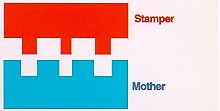 In a third plating stage, each mother is used to create a number of stampers, which are actually used to mold the pit structure onto the CD's.
In a third plating stage, each mother is used to create a number of stampers, which are actually used to mold the pit structure onto the CD's.
5. Clear Disc
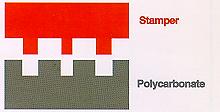 Compact discs are made similarly to conventional records using injection molding techniques and a stamper.
Compact discs are made similarly to conventional records using injection molding techniques and a stamper.
6. CD-ROM Disc
 The information surface is coated with a micron thick layer of aluminum to provide a reflective surface.
The information surface is coated with a micron thick layer of aluminum to provide a reflective surface.
- This is the surface which is actually read by a CD Player. The reflective surface is then protected with a lacquer coating. The disc label is then printed directly onto the disc.
? Cinram used with permission.
Copyright © 2002-03 CD Solutions Inc., All Rights Reserved.
 1-800-860-2376
1-800-860-2376 My Account
My Account

 From the Customer's data, the CD Glass Master is produced.
From the Customer's data, the CD Glass Master is produced.




